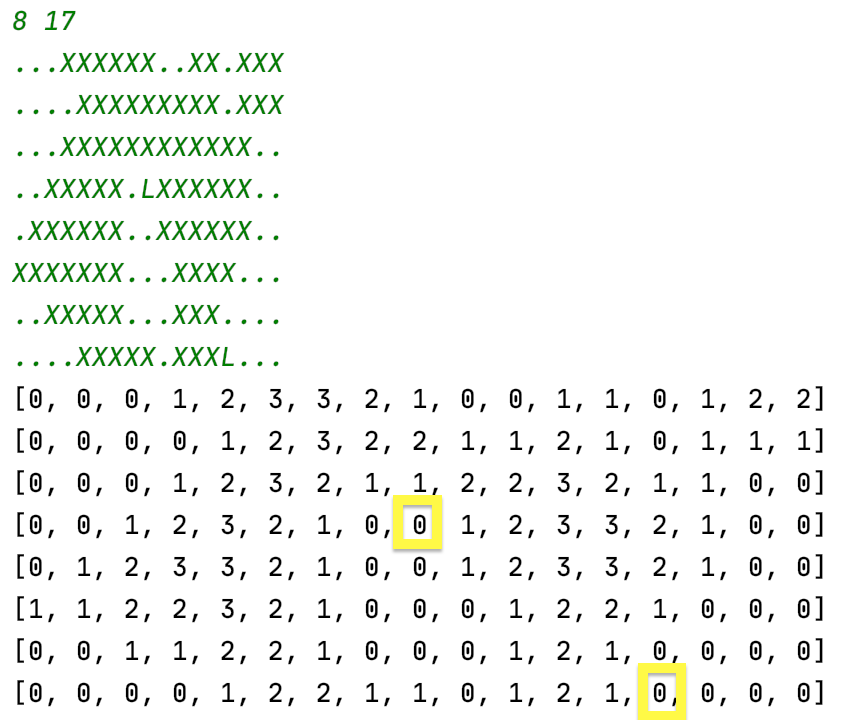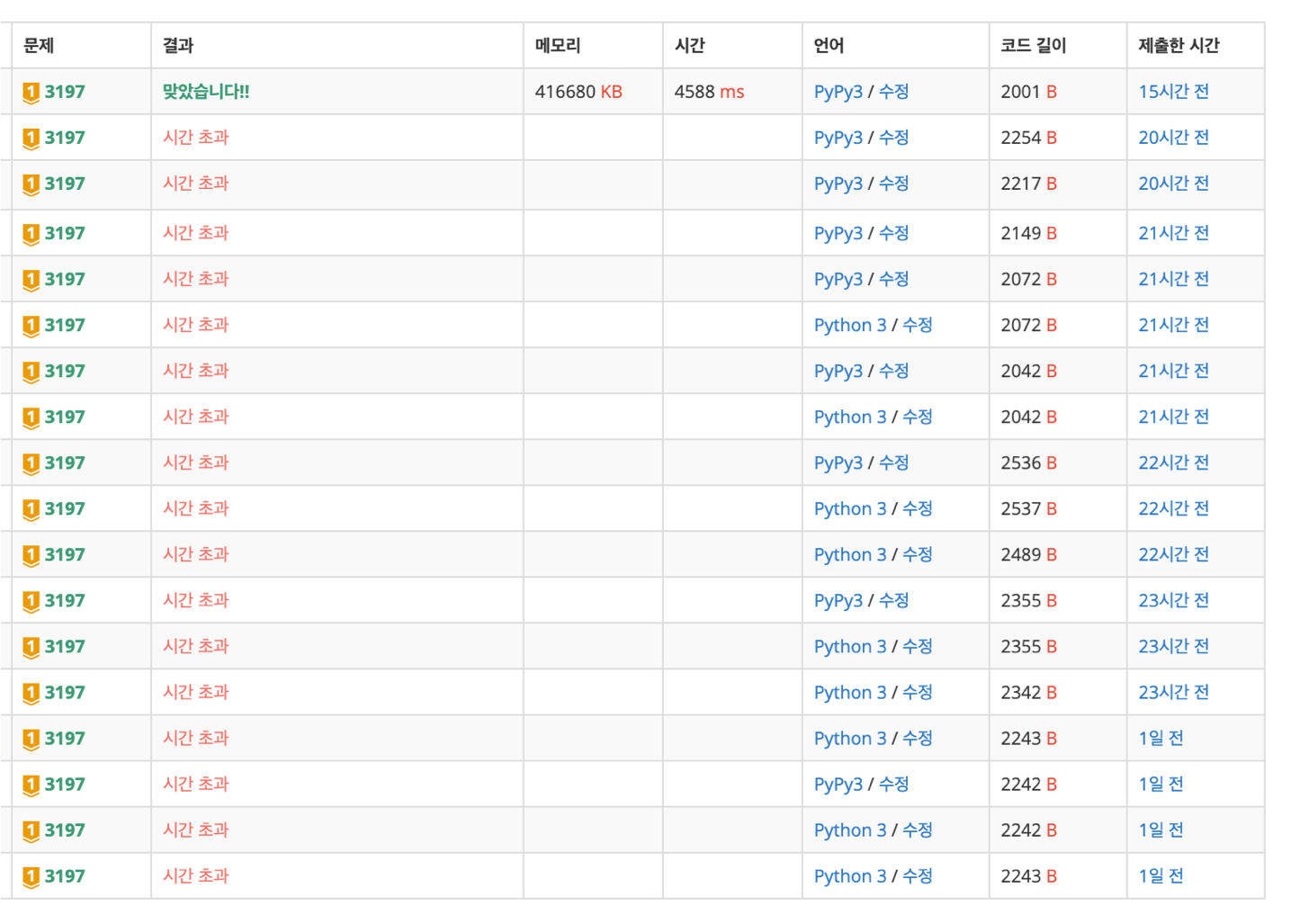문제
맞은 사람이 1440명이라는 골드1 전설의 문제, 백조의 호수에 도전했다.
python3로는 통과가 안되고 통과 조건도 매우 까다로워서 전역변수를 지역변수로 바꾸고 여러 방법을 시도한 끝에 9시간만에 통과할 수 있었다.
첫번째 접근
0일부터 백조가 이동 가능할때까지 얼음 녹이고(bfs) 백조 이동가능성 판단(bfs)하는걸 반복하자
그냥 생각 없이 부르트 포스 방식으로 풀고 봤다.
move_swan(),melt_ice()구현- while 문 돌리면서
move_swan()의 결과가 True일때 count 값 return move_swan()의 결과가 False일때- count += 1
melt_ice():인접한 얼음들 녹이기
전체 코드
import collections
R, C = map(int,input().split(" "))
map = []
dx = [1,-1,0,0]
dy = [0,0,1,-1]
swans = []
ices = []
# 입력
for i in range(R):
line = input()
for j in range(C):
if line[j] == 'L':
swans.append((i, j))
if line[j] == '.':
ices.append((i,j))
map.append(list(line))
def melt_ice():
new_ices = []
global ices
for ice in ices:
y, x = ice
for i in range(4):
t_y, t_x = y + dy[i], x + dx[i]
if t_y < R and t_x < C and t_y >= 0 and t_x >= 0:
if map[t_y][t_x] == 'X':
map[t_y][t_x] = '.'
new_ices.append((t_y,t_x))
ices = new_ices
def move_swan():
y1, x1 = swans[0]
y2, x2 = swans[1]
queue = collections.deque()
visited = set()
for i in range(4):
queue.append((y1 + dy[i], x1 + dx[i]))
while queue:
y, x = queue.popleft()
if (y,x) in visited:
continue
visited.add((y,x))
if (y, x) == (y2, x2):
return True
for i in range(4):
t_y, t_x = y + dy[i], x + dx[i]
if t_y < R and t_x < C and t_y >= 0 and t_x >= 0:
if map[t_y][t_x] != 'X' and (t_y, t_x) not in visited:
queue.append((t_y, t_x))
return False
count = 0
while True:
if move_swan():
break
count += 1
melt_ice()
print(count)결과
시간초과
그럴수밖에 없다
while문을 한번 돌때마다 bfs가 두번 돌아가니 시간 복잡도는
O(max(R, C) X 2 X R X C) 가 된다.
두번째 접근
-
백조가 위치한
L도 물이다!! -
백조 이동 가능성을 계산하기 전에 map을 돌면서 날짜별로 물이 되는 그래프를 미리 만들어 놓는다
- R * C 크기를 가지고 0으로 초기화된 2차원 배열인
times를 만들고 물이 되는 시간을 측정한 값을 저장했다. - 이 과정에서 가장 값이 큰 날짜를 max_day로 정한다.
- R * C 크기를 가지고 0으로 초기화된 2차원 배열인
-
백조 1과 백조2가 만나는 날은 0에서 max_day 사이일 것이다.
-
3번을 계산할때 Binary Search를 이용하자!!!!
Binary Search와 BFS

사진 속 초록색 글씨 부분은 입력값이고 그 아래 검은색 글씨 부분은 얼음이 녹기까지 걸리는 시간을 계산한 배열 times를 출력한 값이다.
노란색 박스는 백조의 위치와 같다.
왼쪽 상단 박스를 백조1, 오른쪽 하단 박스를 백조2라고 지칭하도록 하자
melt_ice()에서 구한 max_day가 3이었기 때문에 백조 1에서 백조2는 3일 안에는 무조건 만난다.
그렇다면 move_swan()으로 백조를 움직일 때 binary search를 통해 최적의 시간을 구할 수 있다.
만약 max_day가 8이고 백조1이 백조2를 만나는데 6일이 걸린다고 하면
day = 0
while day <= max_day:
if move_swan(day):
break
day += 1
print(day) 위와 같이 구현할 수 있는데 시간복잡도는 눈물이 난다.
move_swan()은 크기 RXC인 인접행렬 times를 bfs() 하는 함수이므로 O(max_day X R X C) 가 된다.
하지만 선형탐색이 아닌 이진탐색을 한다면 어떨까?
0에서 출발해서 6이 될때까지 탐색하는게 아니라 0과 8의 중간값인 4에서 출발해서 범위를 반반씩 나눠 간다면 시간 복잡도는 O(log max_day X R X C)이 된다.
결과
pypy3로 통과

전체 코드
# https://www.acmicpc.net/problem/3197
# 백조의 호수
import collections, sys
R, C = map(int, sys.stdin.readline().split(" "))
lake = []
times = [[0 for _ in range(C)] for _ in range(R)]
dx = [1,-1,0,0]
dy = [0,0,1,-1]
swans = []
visited = [[False for _ in range(C)] for _ in range(R)]
waters = collections.deque()
max_time = 0
# 입력
for i in range(R):
line = sys.stdin.readline()
for j in range(C):
if line[j] == 'L':
swans.append((i, j))
if line[j] != 'X':
waters.append((i, j))
visited[i][j] = True
lake.append(list(line[:-1]))
def melt_ice(lake):
max_time = 0
while waters:
y, x = waters.popleft()
for i in range(4):
t_y, t_x = y + dy[i], x + dx[i]
if 0 <= t_y < R and 0 <= t_x < C and visited[t_y][t_x] == False:
if lake[t_y][t_x] == 'X':
times[t_y][t_x] = times[y][x] + 1
waters.append((t_y,t_x))
visited[t_y][t_x] = True
max_time = times[t_y][t_x]
return max_time
def move_swan(lake, swans, max_num):
y1, x1 = swans[0]
y2, x2 = swans[1]
queue = collections.deque()
s_visited = [[False for _ in range(C)] for _ in range(R)]
queue.append((y1, x1))
s_visited[y1][x1] = True
while queue:
y, x = queue.popleft()
for i in range(4):
t_y, t_x = y + dy[i], x + dx[i]
if (t_y, t_x) == (y2, x2):
return True
if 0 <= t_y < R and 0 <= t_x < C and s_visited[t_y][t_x] == False:
if lake[t_y][t_x] == 'L' or lake[t_y][t_x] == '.' or times[t_y][t_x] <= max_num:
s_visited[t_y][t_x] = True
queue.append((t_y, t_x))
return False
_min , _max = 0, melt_ice(lake)
answer = _max
while _min <= _max:
mid = (_min + _max) // 2
if move_swan(lake, swans, mid):
_max = mid - 1
answer = min(answer, mid)
else:
_min = mid + 1
print(answer)
